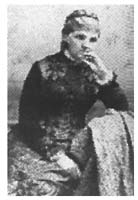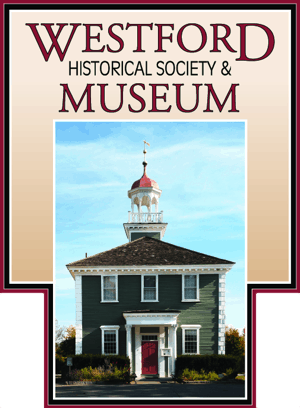
Why Edgar Allen Poe called Nancy Richmond, “Anne” is a mystery.
By James Van Bever (June/July 2022)
It is believed that after Poe started to call her Annie that she never again answered to another name. Even her husband addressed her by her new name. After her husband’s death, she legally changed her name to Annie.
On July 10, 1848, Westford native Nancy (Heywood) Richmond along with her brother Bardwell Heywood and sister Sarah attended a lecture at the Wentworth Hall in Lowell, Massachusetts entitled “The Poets and Poetry of America.” The man giving the lecture was a gothic writer named Edgar Allan Poe. It would be the beginning of a remarkable relationship between Nancy who Poe would later refer to as Annie and the troubled poet. *
Nancy Heywood was born in Westford in 1820. She was the daughter of Amos and Lydia (Buck) Heywood. The couple had an infant son who died one year before Nancy was born followed by a son Amos Bardwell and another daughter Sarah. The family lived on Graniteville Road which was near to the center of town.
Nancy graduated from Westford Academy in 1838 and at the age of twenty married Charles B. Richmond, a wealthy mill owner from Lowell. The Richmond family owned five paper mills in the Mill City and employed 125 men, women, and children. After her marriage to Richmond the couple resided in Lowell and had one daughter named Caroline.
In Lowell, the Richmonds lived near Jane Locke and her husband John. It was Jane Locke who had invited Edgar Allan Poe to the Mill City to give his July 10th lecture and it was Jane who greeted Poe when he arrived at the Lowell train station on Middlesex Street. Mrs. Locke “was a literary lady of odes and songs for various civic occasions.” She had also provided Poe and his family financial assistance prior to his arrival in the Textile City. Locke was forty-three years old, and a mother who was suffering from the early onset of tuberculosis.
After the lecture, Jane Locke introduced Poe to Nancy Richmond. The Richmonds then invited the poet to spend the night at their home on Ames Street in Lowell. Nancy and her husband Charles were both fans of the writer. That evening Nancy and Poe stayed up talking until near dawn. After the night was over, a deep and everlasting friendship developed between Mrs. Richmond and the gothic writer. It was during this visit that Poe would author a poem about Nancy called “Annie.”
When Edgar Allan Poe arrived in the Mill City in July 1848, he was a depressed and lonely man. His twenty-four-year-old wife Virginia had died from tuberculosis just a few months before his visit to Lowell. His wife’s death was not the only tragedy that had struck the writer, his mother and stepmother has died from the same disease earlier in Poe’s life.
During Poe’s first visit to Lowell the poet and Annie would spend less than one full day together. But it was Annie’s “sweet and sisterly concern” shown by her that was important to him. Poe considered Annie Richmond to be intelligent and “the ideal 19th century woman.” She was “indeed a special angel in the mind of the beleaguered poet.”
But most Edgar Allan Poe scholars agree that the relationship between Poe and Annie was nothing more than plutonic. Historians feel that his relationship and attachment to Annie Richmond was more about trying to fill a void because of the loss of his wife Virginia and his dependency on excessive drinking and drug dependency.
Although there must have been some talk about impropriety between the famous writer and Annie Richmond, it was obvious that her role in Poe’s life was an empathic and caring one. Mrs. Richmond’s real feelings toward the writer “were one of awe and admiration, coupled with the sympathy that she felt for one who was suffering.” Nancy’s main fault may have been that she was a bit too naïve and placed too much faith in her mysterious friend.
Poe’s visit to Lowell in 1848 was not only the start of a remarkable relationship between the Westford native and Edgar Allan Poe, but it was also the start of an extraordinary relationship between the gothic poet and the Town of Westford. Poe would later consider Westford to be a “paradise” and thought of moving to the Lowell suburb.
Edgar Allan Poe not only loved Annie Richmond, but he also loved the Town of Westford. Poe said of the town, “Indeed I spent many hours here, sitting by the fire at twilight and often walking up Prospect Hill. There is no place on heaven and earth where I feel such peace as here.” The poet loved to wander the hills and valleys of Westford and felt that the town was his sanctuary. Poe went on to say that “when he climbed to the top of Prospect Hill on a glorious Indian summer day, he said it could be paradise beyond his wildest hopes.”
It was in October 1848 that Mr. Poe made his first visit to Westford. Annie Richmond’s brother Amos Bardwell Heywood had invited the poet to spend some time in his hometown. Bardwell at the time was the principal at the Franklin Grammar School in Lowell but was still living with his parents Amos and Lydia and his sister Sarah in their home on Graniteville Road.
During Edgar Allan Poe’s first visit to Westford, he participated in a reading circle conducted by the Heywood family. The Heywoods were a literary family and were interested in Mr. Poe’s work. At the Heywood home the writer read a number of his works including “The Raven”,” Ulalume,” “The Bell,” and others.
It was during this meeting at Amos Heywood’s home that the poet became involved in a debate with Reverend John B. Willard, who was the twenty-six-year-old pastor at the First Parish Church in Westford. Willard was a Brown University graduate, described by a historian as an “eccentric preacher.” Bardwell would later comment that it was a “treat to witness the debate between Poe and Willard” and he suggested that the young clergyman had found himself up against an antagonist as does not often meet.
In May 1849, the famous gothic writer spent three more days in Westford, again staying at the Heywood’s home on Graniteville Road. It was during this visit that Poe might have gathered more background for his short story Landor’s Cottage. This is evident since the way Poe describes the landscape in Landor’s Cottage resembles the hills and valleys of Westford.
On Edgar Allan Poe’s last day in Westford, the poet walked Sarah Heywood to her classes at Westford Academy. She had entered Westford Academy in 1845. The walk from Amos Heywood’s house to the Academy could not have taken more than ten minutes or so, but the memories of their parting and goodbyes would remain in Sarah Heywood’s thoughts for the remainder of her life.
Prior to Poe’s death, he contemplated building a cottage in Westford and moving to town. He wanted to be close to the Heywoods. His idea was to move to Westford along with his mother-in-law Maria Clemm to whom he was close. Mrs. Clemm was also Poe’s aunt. Poe felt that Westford might be a “Paradise within him and his mother-in-law might reside.”
Sadly, Poe never realized his dream of living in a small cottage in Westford. On October 7, 1849, he died shortly after collapsing in a tavern in Baltimore, Maryland. Edgar Allan Poe was only forty years old at the time of his death.
Later in life, Annie Richmond became involved in civic affairs in the city of Lowell. She was the founder and president of the “Home of Young Women and Children.” Richmond would also become one of the founders of Lowell General Hospital and became associated with such women’s rights leaders as Lucy Stone and Mary A. Livermore.
The Richmond’s owned a seashore home in Beverly, Massachusetts which was located next to a home owned by President Howard Taft. Taft’s home would later become the summer Whitehouse after Mr. Taft became president. Later, the Richmond home became the property of Annie’s sister Sarah, who lived in the house for many years.
Nancy Annie Richmond died in February 1898. At her gravesite at the Lowell Cemetery, the name “Annie” appears on her tombstone. Her name and memory live on in the history of American Literature.
Sources:
Parker, Brad. The Saga of Eddie & Annie. Pages, 1-2, 14, 16, 32-33, 35, 40.
Parker, Brad. Poe’s Beautiful Angel. Pages, .47, 74, 123-24.
Nancy Zaroulis. The Poe Papers: A Tale of Passion. Pages, 120-21.
“And Have you Heard.” Anne K. Donaghue. Lowell Sun, January 9, 1939, p. 67.
Ibid. Talbot Paper, Notable Contribution to “Poeiana” Read at Local Celebration. January 19,1943, p. 42.
Ibid. “Lowell’s Strangest Love Story Left Poe with a Broken Heart.” Russ McCollister, December 28, 1952, p. 58.
Ibid. “A chilling tale in the Poe Style.” May 15, 1977, p. 31.
Ibid. “Horror Story Revisited his Old Haunts.” Laurin Mc Falls. October 31, 1983.
Lowell Courier Citizen, February 3, 1941, p.11.
Edgar Allan Day paper. By Brad Parker.
“Poe’s tragic figure in Westford.” Virginia Kimball. Westford Eagle, October 27, 1983, p.6.
For Annie by Edgar Allan Poe
Edgar Allan Poe dedicated this poem, ‘For Annie’, to his Platonic friend Nancy Locke Heywood with whom he had a strong but complicated relationship. Through this poem, Poe expresses his gratitude for the lady.
In one’s life, there are a few persons who help that person to sail through the difficulties selflessly out of pure love. One cannot forget them ever. They are like the torchbearers who show the right way to a person. In Poe’s case, Nancy L. Heywood was one of them. She helped him to recover from the fitful fever of “Living” and taught him there was still hope. In his deteriorating mental condition, she was the divine “light”. For this reason, he penned down ‘For Annie’ to glorify her role in his life. (Poem Analysis)
